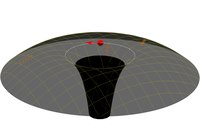
Photo from wikipedia
Radiation chemists have been routinely using high-dose microsecond-pulsed irradiation for almost 60 years, involving many thousands of studies, in the technique of "pulse radiolysis". This involves dose rates broadly similar… Click to show full abstract
Radiation chemists have been routinely using high-dose microsecond-pulsed irradiation for almost 60 years, involving many thousands of studies, in the technique of "pulse radiolysis". This involves dose rates broadly similar to the FLASH regimen now attracting interest in radiotherapy and radiobiology. Using the experience gained from radiation chemistry, two scenarios are examined here that may provide a mechanistic basis for any differential response in normal tissues versus tumors in FLASH radiotherapy. These are: 1. possible depletion of a chemical critical to the response to radiation, and 2. radical-radical reactions as a possible cause of effects occurring mainly with high-intensity pulsed radiation. The evidence for changes in relative levels of so-called "reactive oxygen species" produced after irradiation using FLASH versus conventional irradiation modalities is also examined.
Journal Title: Radiation research
Year Published: 2020
Link to full text (if available)
Share on Social Media: Sign Up to like & get
recommendations!